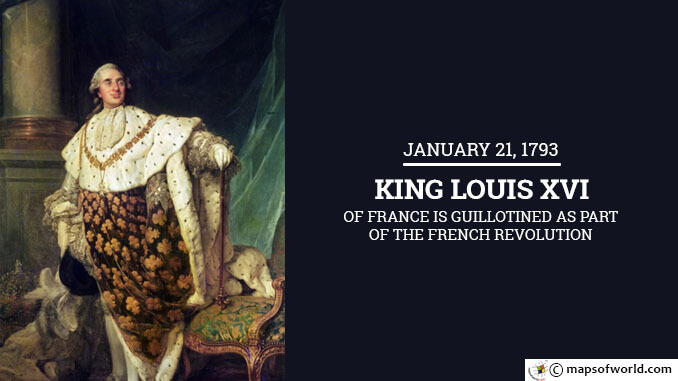On January 21, 1793, French King Louis XVI was executed by guillotine at the Place de la Revolution in Paris following a conviction of high treason by the National Convention. The execution was a direct result of the fall of the Bourbon monarchy and marked an important turn of events in the French Revolution. Louis was born at Versailles in August 1754. In 1770, a royal marriage was arranged between Louis and Marie Antoinette, the daughter of the Emperor and Empress of Austria in an alliance that was intended to consolidate cordial relations between France and Austria. By 1774, Louis had ascended the throne previously held by his grandfather Louis XV as the King of France. By the time the excesses of the Bourbon royal family had not only gained the monarchy the displeasure of the people but also had nearly emptied the royal exchequer. Wars, extravagances, and fantastic constructions had led the economy to ruin and the rising costs had made basic items of necessity beyond the reach of an ordinary man. Failing crops and soaring unemployment fueled the rage of the French masses. Marie Antoinette became the cause for much contention, as the relations with Austria started to sour. In 1788, Louis made one last attempt to rescue the country from what looked like certain economic ruin by reinstating the French National Assembly or the Estates-General. The Assembly was meant to have representation from all the three “estates” of the French people – the clergy, the nobles, and the commons. The Third Estate, the commons, was incensed as the King disallowed the three estates to meet simultaneously. They declared that they alone were the representatives of the French people and soon seized all power; the Third Estate started to curtail the monarchy, leading up to the French Revolution. On July 14, 1789, mobs of Parisians stormed the hated prison at the Bastille, where the ammunitions of the French military were believed to be stored. Louis, while pretending to accept the revolution and acquiescing to the demands of the people, kept resisting all attempts to reform the monarchy into a more suitable form. The King’s consort, Marie Antoinette had acquired a terrible reputation due to her scant regard for established French royal traditions. The liberty she enjoyed with the upbringing of her children and her attempts to repair the image of the royalty were perceived negatively. As the Dauphine of France she had incurred much displeasure due to her extravagant expenditure in times of famine and due to the rumors of treason and promiscuity that had become a matter of gossip through the country. In many cases the Queen had been innocent, but the accusations leveled against her had been difficult to quell. In October 1789, thousands of French people marched towards the royal palace at Versailles. After a violent demonstration here, Louis accepted some of the proposed reforms. The royal family was forced to take up residence at the Palace de Tuileries. By June 1791, the revolution had reached a climax and the royal family was forced to flee to Austria. They were, however, apprehended at Varennes and brought back to Paris. In August 1792, the King and Queen were arrested. The Convention abolished the monarchy and declared France a republic. In January the following year, Louis was tried by the National Convention which had replaced the National Assembly and was sentenced to death by guillotine the following day. Louis spent the evening of January 20 saying goodbye to his wife and children. He rose at five the next morning and attended mass. After confession, an English priest Henry Essex Edgeworth accompanied Louis. In his personal account, Edgeworth describes the gravity and courage with which the king bore his last hours. He went with a dignity rare to men and refused to be bound. According to Edgeworth, the king’s last words were “I die innocent of all the crimes laid to my charge; I pardon those who have occasioned my death; and I pray to God that the blood you are going to shed may never be visited on France.” Louis’ wife, Marie Antoinette was also tried by the National Convention nine months later. She was found guilty of treason and sentenced to the guillotine on October 16. With the execution of Louis started what would be described by historians as the “Reign of Terror”, one of the most anarchic periods of revolution – unexpected in the history of a country of such refinement as France. Records say, 16,594 French men and women were executed by guillotine and over 25,000 more in other executions across France. The country was torn apart by the conflict between the Jacobins and the Girondins – rival political factions. The execution saw the last of the Bourbon kings till Louis XVIII, known as “the Desired”, took over the as the King of France in 1814. You may also like : January 21 1954 – USS Nautilus, the First Nuclear-Powered Submarine, is Christened in Connecticut
January 21 1793 – King Louis XVI Of France Is Guillotined As Part Of The French Revolution
On January 21, 1793, French King Louis XVI was executed by guillotine at the Place de la Revolution in Paris following a conviction of high treason by the National Convention.…
445
